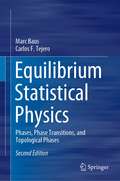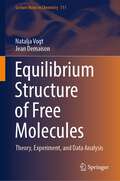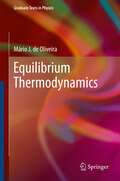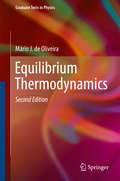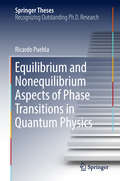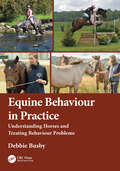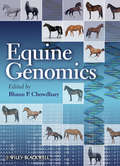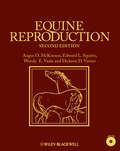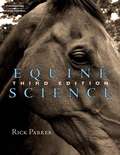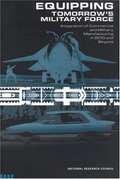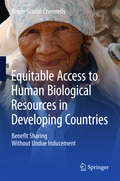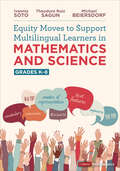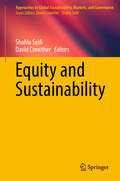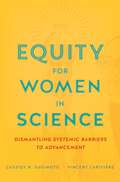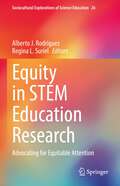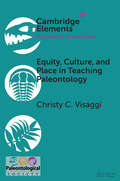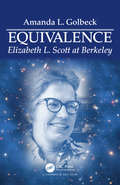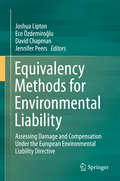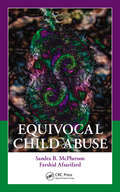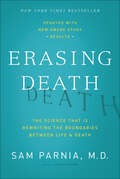- Table View
- List View
Equilibrium Statistical Physics: Phases, Phase Transitions, and Topological Phases
by Marc Baus Carlos F. TejeroThis is a textbook which gradually introduces the student to the statistical mechanical study of the different phases of matter and to the phase transitions between them. Throughout, only simple models of both ordinary and soft matter are used but these are studied in full detail. The subject is developed in a pedagogical manner, starting from the basics, going from the simple ideal systems to the interacting systems, and ending with the more modern topics. The textbook provides the student with a complete overview, intentionally at an introductory level, of the theory of phase transitions. All equations and deductions are included.
Equilibrium Structure of Free Molecules: Theory, Experiment, and Data Analysis (Lecture Notes in Chemistry #111)
by Natalja Vogt Jean DemaisonThis book examines around 400 of the most striking examples of structural studies of free molecules—selected and analyzed by virtue of the unique molecular complexity and novelty of the experimental techniques used. The properties of chemical, pharmaceutical, and biological compounds depend mainly on their molecular structure, the determination of which is of fundamental interest. Featuring high-quality structural data determined using modern techniques in electron diffraction and high-resolution spectroscopy, the book is an indispensable resource for graduate students and professional scientists specializing in structural chemistry and other relevant fields.
Equilibrium Thermodynamics
by Mário J. OliveiraThis textbook provides an exposition of equilibrium thermodynamics and its applications to several areas of physics with particular attention to phase transitions and critical phenomena. The applications include several areas of condensed matter physics and include also a chapter on thermochemistry. Phase transitions and critical phenomena are treated according to the modern development of the field, based on the ideas of universality and on the Widom scaling theory. For each topic, a mean-field or Landau theory is presented to describe qualitatively the phase transitions. These theories include the van der Waals theory of the liquid-vapor transition, the Hildebrand-Heitler theory of regular mixtures, the Griffiths-Landau theory for multicritical points in multicomponent systems, the Bragg-Williams theory of order-disorder in alloys, the Weiss theory of ferromagnetism, the Néel theory of antiferromagnetism, the Devonshire theory for ferroelectrics and Landau-de Gennes theory of liquid crystals. This textbook is intended for students in physics and chemistry and provides a unique combination of thorough theoretical explanation and presentation of applications in both areas. Chapter summaries, highlighted essentials and problems with solutions enable a self sustained approach and deepen the knowledge.
Equilibrium Thermodynamics
by Mário J. de OliveiraThis textbook provides an exposition of equilibrium thermodynamics and its applications to several areas of physics with particular attention to phase transitions and critical phenomena. The applications include several areas of condensed matter physics and include also a chapter on thermochemistry. Phase transitions and critical phenomena are treated according to the modern development of the field, based on the ideas of universality and on the Widom scaling theory. For each topic, a mean-field or Landau theory is presented to describe qualitatively the phase transitions. These theories include the van der Waals theory of the liquid-vapor transition, the Hildebrand-Heitler theory of regular mixtures, the Griffiths-Landau theory for multicritical points in multicomponent systems, the Bragg-Williams theory of order-disorder in alloys, the Weiss theory of ferromagnetism, the N#65533;el theory of antiferromagnetism, the Devonshire theory for ferroelectrics and Landau-de Gennes theory of liquid crystals. This new edition presents expanded sections on phase transitions, liquid crystals and magnetic systems, for all problems detailed solutions are provided. It is intended for students in physics and chemistry and provides a unique combination of thorough theoretical explanation and presentation of applications in both areas. Chapter summaries, highlighted essentials and problems with solutions enable a self sustained approach and deepen the knowledge. It is intended for students in physics and chemistry and provides a unique combination of thorough theoretical explanation and presentation of applications in both areas. Chapter summaries, highlighted essentials and problems with solutions enable a self sustained approach and deepen the knowledge.
Equilibrium and Nonequilibrium Aspects of Phase Transitions in Quantum Physics (Springer Theses)
by Ricardo PueblaIn this book, the equilibrium and nonequilibrium properties of continuous phase transitions are studied in various systems, with a special emphasis on understanding how well-established universal traits at equilibrium may be extended into the dynamic realm, going beyond the paradigmatic Kibble–Zurek mechanism of defect formation. This book reports on the existence of a quantum phase transition in a system comprising just a single spin and a bosonic mode (the quantum Rabi model). Though critical phenomena are inherent to many-body physics, the author demonstrates that this small and ostensibly simple system allows us to explore the rich phenomenology of phase transitions, both in- and out-of-equilibrium. Moreover, the universal traits of this quantum phase transition may be realized in a single trapped-ion experiment, thus avoiding the need to scale up the number of constituents. In this system, the phase transition takes place in a suitable limit of system parameters rather than in the conventional thermodynamic limit – a novel notion that the author and his collaborators have dubbed the finite-component system phase transition. As such, the results gathered in this book will open promising new avenues in our understanding and exploration of quantum critical phenomena.
Equine Behaviour in Practice: Understanding Horses and Treating Behaviour Problems
by Debbie BusbyCombining an in-depth exploration of equine behaviour with clinical practice from a new progressive perspective, Equine Behaviour in Practice: Understanding Horses and Treating Behaviour Problems focuses not just on the horse’s behaviour but also on the behaviour of the human interacting with the horse. Acclaimed Clinical Equine Behaviourist Debbie Busby delivers evidence-based knowledge that will equip readers with the understanding and skills to become effective equine behaviour consultants. Supported by considered discussion of how and why horses sometimes struggle to cope, the book comprehensively explains how to consult on and treat a range of equine behaviour problems. Rather than providing a formulaic "here’s the problem; here’s how to fix it", Busby encourages readers to develop a critical biopsychosocial evaluation based on an understanding of how horses evolved, their ethological and physiological adaptations, how they learn, and how their welfare and wellbeing can be assessed. KEY FEATURES: Part 1 explains theories of equine evolution and the thin veneer of domestication Part 2 describes psychological and physiological theories of how horses learn, and how this can be applied in training and behaviour modification Part 3 illustrates this with reference to relevant legislation and widely used animal welfare models, as well as assessments of abnormal and stereotypic behaviour and practical aspects of measuring welfare Part 4 turns to the theory and practice of behaviour consulting, in three chapters divided into elements of behavioural assessment and treatment planning Part 5 examines the use of psychopharmaceuticals in behaviour therapy, discussing the roles of the behaviour consultant and the referring veterinary surgeon Bridging the gap between science and practice, this book is a must-read for equine behaviour and veterinary students, equine behaviour consultants and practitioners, horse trainers, interested leisure riders and competition riders. It will empower equine professionals to combine behavioural and welfare knowledge with counselling and coaching skills to support horse owners in a mutual flourishing, enriching the lives of both species.
Equine Genomics
by Bhanu P. ChowdharyAnalysis of the equine genome began just over a decade ago, culminating in the recent complete sequencing of the horse genome. The availability of the equine whole genome sequence represents the successful completion of an important era of equine genome analysis, and the beginning of a new era where the sequence information will catalyze the development of new tools and resources that will permit study of a range of traits that are economically important and are significant to equine health and welfare.Equine Genomics provides a timely comprehensive overview of equine genomic research. Chapters detail key accomplishments and the current state of research, as well as looking forward to possible applications of genomic technologies to horse breeding, health, and welfare. Equine Genomics delivers a global overview of the topic and is seamlessly edited by a leading equine genomics researcher. Equine Genomics is an indispensible source of information for anyone with an interest in this increasingly important field of study, including equine genomic researchers, clinicians, animal science professionals and equine field veterinarians.
Equine Reproduction
by Edward L. Squires Wendy E. Vaala Angus O. Mckinnon Dickson D. VarnerNow in a much-anticipated two-volume new edition, this gold-standard reference stands as the most comprehensive and authoritative text on equine reproduction. Serving theriogenologists, practitioners and breeders worldwide as a one-stop resource for the reproductive assessment and management of equine patients, Equine Reproduction, Second Edition provides detailed information on examination techniques, breeding procedures, pregnancy diagnosis and management, reproductive tract diseases and surgery, and foaling. A companion CD offers hundreds of images from the book in color. For the Second Edition, the stallion, mare and foal sections have been thoroughly updated and revised to include the latest information on every subject. New topics include discussion of nutritional and behavioral factors in the broodmare and stallion, parentage testing, fetal sexing and the health and management of older foals, weanlings and yearlings. Additionally, this outstanding Second Edition features a new section on assisted reproductive techniques, including detailed information on artificial insemination, in-vitro fertilization, embryo transfer and technology.
Equine Science (3rd edition)
by Rick ParkerHorses hold a special place in North America's history and culture. As America evolved, horses contributed to the economy by providing power for transportation and industry. Today horses still contribute to the economy but in a much different way. According to a study commissioned by the American Horse Council Foundation, the 9.2 million horses in the United States contribute $39 billion annually in direct economic impact and support 1.4 million jobs on a full-time basis. When indirect spending is included, the horse industry's economic impact reaches $102 billion annually. The overall economic impact of horses comes from racing, recreation, sports, rodeos, farm work, pleasure riding, and competitions. While millions of people participate in the horse industry as spectators, almost 5 million Americans are involved in the industry as horse owners, service providers, employees, and volunteers. Horses are found in every state, and 45 states have at least 20,000 horses. The horse industry is vital and growing. With this vitality and growth comes the need for information about horses, so the numbers of horse-related educational programs, books, pamphlets, videos, and Internet sites are increasing rapidly.
Equipping Tomorrow's Military Force: Integration of Commercial and Military Manufacturing in 2010 and Beyond
by National Research CouncilInformation on the Integration of Commercial and Military Manufacturing in 2010 and Beyond
Equitable Access to Human Biological Resources in Developing Countries
by Roger Scarlin ChennellsThe main question explored by the book is: How can cross-border access to human genetic resources, such as blood or DNA samples, be governed in such a way as to achieve equity for vulnerable populations in developing countries? The book situates the field of genomic and genetic research within global health and research frameworks, describing the concerns that have been raised about the potential unfairness in exchanges during recent decades. Access to and sharing in the benefits of human biological resources are aspects not regulated by any international legal framework such as the Convention on Biological Diversity, which applies only to the exchange of plants, animals and microorganisms, as well as to associated traditional knowledge. Examples of genetic research perceived as exploitative are provided in order to illustrate the legal vacuum concerning the global governance of human genetic resources. The main conclusions drawn from the legal and ethical analysis are: * Benefit sharing is crucial in order to avoid the exploitation of developing countries in human genetic research. * With functioning research ethics committees, undue inducement is less of a concern in genetic research than in other areas of medical research (e. g. clinical trials). * Concerns remain over research involving indigenous populations; accordingly, recommendations are provided. In drawing these conclusions, the book addresses in detail a highly pressing topic in global bioethics and international law. In this regard, it combines bioethical arguments with jurisprudence, in particular with reference to the law of equity and the legal concepts of duress (coercion), unconscionable dealing, and undue inducement.
Equity Moves to Support Multilingual Learners in Mathematics and Science, Grades K-8 (Corwin Mathematics Series)
by Ivannia Soto Theodore Sagun Michael BeiersdorfA strengths and assets-based approach to multilingual learner success As the number of multilingual learners (MLLs) in US schools continues to grow, educators need to learn the moves necessary to support the success of these students in mathematics and science. Equity Moves to Support Multilingual Learners in Mathematics and Science, Grades K-8 focuses on the literacy opportunities that MLLs can achieve when language scaffolds are taught alongside rigorous math and science content. It provides a framework teachers can use to develop equity-centered, scaffolded math, science, or STEAM lessons. Readers will find Anchor phenomena that demonstrate issues with lesson design and delivery and highlight areas to include language and content scaffolds Examples for honoring the languages of students, families, and communities Culturally responsive techniques and easy-to-use tables featuring the equity moves Vignettes showcasing the equity move in the classroom setting A focus on four language demands: vocabulary, discourse, multiple modes of representation, and text features With an assets-based approach to what MLLs can do, this book helps teachers unpack the language demands of mathematics and science and encourages reflection of their own practices in scaffolding for language and culture.
Equity Moves to Support Multilingual Learners in Mathematics and Science, Grades K-8 (Corwin Mathematics Series)
by Ivannia Soto Theodore Sagun Michael BeiersdorfA strengths and assets-based approach to multilingual learner success As the number of multilingual learners (MLLs) in US schools continues to grow, educators need to learn the moves necessary to support the success of these students in mathematics and science. Equity Moves to Support Multilingual Learners in Mathematics and Science, Grades K-8 focuses on the literacy opportunities that MLLs can achieve when language scaffolds are taught alongside rigorous math and science content. It provides a framework teachers can use to develop equity-centered, scaffolded math, science, or STEAM lessons. Readers will find Anchor phenomena that demonstrate issues with lesson design and delivery and highlight areas to include language and content scaffolds Examples for honoring the languages of students, families, and communities Culturally responsive techniques and easy-to-use tables featuring the equity moves Vignettes showcasing the equity move in the classroom setting A focus on four language demands: vocabulary, discourse, multiple modes of representation, and text features With an assets-based approach to what MLLs can do, this book helps teachers unpack the language demands of mathematics and science and encourages reflection of their own practices in scaffolding for language and culture.
Equity and Science Education Reform
by Sharon J. LynchThis lucid, accessible, thought-provoking discussion of issues related to equity in science education reform is for science educators, including idealists and exacting pragmatists, who are dedicated to exploring what it means to put into practice rallying cries like "science literacy for all," "equity and excellence," and "standards-based reform." Intended as an enjoyable and stimulating read, as opposed to a comprehensive summary of everything ever written about equity in science education, it is a response to the new science education standards and reforms, with their goal of science literacy for all. If this goal is to be taken seriously, the implications are immense. A central purpose of this book is to project and discuss how achieving this goal would affect science education reform and vice versa. The work is research based, using statistics, tables, and figures drawn primarily from NSF reports and other public information documents to provide a foundation for equity concerns. However, these statistics are not the main focus of the book. Rather, they are used to make a case, backed by pertinent research, the literature on best practice, and provocative examples from schools and classrooms. Charts, tables, and graphic organizers provide visual evidence and enhance the arguments presented. Moving from research-based studies to classroom stories, Equity and Science Education Reform encourages readers to think about the complexity of the issues. No easy answers or quick fixes are offered. Researching across "identity" areas and attempting to unite them in a discussion that recognizes both the common elements as well as important distinctions, it provides a comprehensive picture of equity concerns across ethnicity, class, gender, and location. Encompassing a broad literature in science education, reform and policy, and equity issues, it offers an "equity schema" as a unifying concept to guide discussion throughout. This book is based, in part, on a series of nine background papers that were commissioned by the American Association for the Advancement of Science's Project 2061 and the summary document, which was written by the author of this book. But it goes far beyond the original study to provide a consistent, coherent, and lively discussion that vividly illustrates the issues raised by the experiences of teachers and students who are struggling with equity principles in the context of science education reform.
Equity and Sustainability (Approaches to Global Sustainability, Markets, and Governance)
by David Crowther Shahla SeifiThis book delves into the multifaceted concept of sustainability, placing a particular emphasis on the social dimension and its intersection with economic and environmental considerations. It examines how individuals, corporations, and institutions can adapt their behaviors to align with sustainable practices. Through a global perspective, the book explores various aspects of behavior changes required for sustainability, highlighting diverse approaches adopted in different regions around the world. One of the central themes explored in this book is the notion of equity in sustainability. While it is acknowledged that complete equality is unattainable, the book argues that achieving fairness in outcomes is essential for the stability and longevity of sustainable practices. Without equity, there is a risk of social unrest and instability, which could undermine the sustainability agenda. Drawing on contributions from scholars representing diverse international backgrounds, the book offers fresh perspectives and innovative solutions to the challenges of sustainability. Rooted in the tradition of the Social Responsibility Research Network (SRRNet), this book embodies the network's ethos of promoting dialogue, sharing best practices, and seeking relevant solutions. It aims to inspire new thinking and action toward a more sustainable and equitable future for all, presenting a blend of academic rigor and practical insights. Through its exploration of sustainability from a social perspective, this book contributes to the ongoing discourse on how to address the pressing global challenges of our time.
Equity for Women in Science: Dismantling Systemic Barriers to Advancement
by Cassidy R. Sugimoto Vincent LarivièreThe first large-scale empirical analysis of the gender gap in science, showing how the structure of scientific labor and rewards—publications, citations, funding—systematically obstructs women’s career advancement.If current trends continue, women and men will be equally represented in the field of biology in 2069. In physics, math, and engineering, women should not expect to reach parity for more than a century. The gender gap in science and technology is narrowing, but at a decidedly unimpressive pace. And even if parity is achievable, what about equity?Equity for Women in Science, the first large-scale empirical analysis of the global gender gap in science, provides strong evidence that the structures of scientific production and reward impede women’s career advancement. To make their case, Cassidy R. Sugimoto and Vincent Larivière have conducted scientometric analyses using millions of published papers across disciplines. The data show that women are systematically denied the chief currencies of scientific credit: publications and citations. The rising tide of collaboration only exacerbates disparities, with women unlikely to land coveted leadership positions or gain access to global networks. The findings are unequivocal: when published, men are positioned as key contributors and women are relegated to low-visibility technical roles. The intersecting disparities in labor, reward, and resources contribute to cumulative disadvantages for the advancement of women in science.Alongside their eye-opening analyses, Sugimoto and Larivière offer solutions. The data themselves point the way, showing where existing institutions fall short. A fair and equitable research ecosystem is possible, but the scientific community must first disrupt its own pervasive patterns of gatekeeping.
Equity in STEM Education Research: Advocating for Equitable Attention (Sociocultural Explorations of Science Education #26)
by Alberto J. Rodriguez Regina L. SurielThis book focuses on the creative and transformative work of scholars who are advancing social justice through science/STEM education with limited resources. It draws attention to the significant body of work being conducted in various contexts so that readers could reflect and appreciate how much broader and transformative our impact could be if funding agencies, policy makers, and other researchers would widen their perspective and seek to promote social justice-driven scholarship. Public funding for STEM research on K-12 and teacher education that targets special populations is often limited and tends to favor mainstream research. This book contains case studies on innovative and promising STEM research with a focus on equity, diversity and social justice that are funded with limited or no public funding. It also presents anecdotes from authors in relation to their struggles in either securing funding for their reported study or seeking to publish its findings. This provides more context to the challenges of conducting non-mainstream research in science/STEM education. Most of the contributors are scholars of color and/or women conducting research with traditionally marginalized populations in science/STEM. Thus, this book offers an additional venue to share the voices of marginalized scholars and allies seeking to broaden our understanding of the challenges and successes of promoting equity, diversity, and social justice in various educational contexts.
Equity, Culture, and Place in Teaching Paleontology: Student-Centered Pedagogy for Broadening Participation (Elements of Paleontology)
by Christy C. VisaggiThe diversity crisis in paleontology refers not to modern biota or the fossil record, but rather how our discipline lacks significant representation of individuals varying in race, ethnicity, and other aspects of identity. This Element is a call to action for broadening participation through improved classroom approaches as described in four sections. First, a brief review of the crisis and key concepts are presented. Next, culturally responsive pedagogy and related practices are introduced. Third, specific applications are offered for drawing cultural connections to studying the fossil record. Finally, recommendations including self-reflection are provided for fostering your own cultural competency. Our discipline offers much for understanding earth history and contributing new knowledge to a world impacted by humans. However, we must first more effectively welcome, support, and inspire all students to embrace meaning and value in paleontology; it is critical for securing the future of our field.
Equivalence: Elizabeth L. Scott at Berkeley
by Amanda L. GolbeckEquivalence: Elizabeth L. Scott at Berkeley is the compelling story of one pioneering statistician’s relentless twenty-year effort to promote the status of women in academe and science. Part biography and part microhistory, the book provides the context and background to understand Scott’s masterfulness at using statistics to help solve societal problems. In addition to being one of the first researchers to work at the interface of astronomy and statistics and an early practitioner of statistics using high-speed computers, Scott worked on an impressively broad range of questions in science, from whether cloud seeding actually works to whether ozone depletion causes skin cancer. Later in her career, Scott became swept up in the academic women’s movement. She used her well-developed scientific research skills together with the advocacy skills she had honed, in such activities as raising funds for Martin Luther King Jr. and keeping Free Speech Movement students out of jail, toward policy making that would improve the condition of the academic workforce for women. The book invites the reader into Scott’s universe, a window of inspiration made possible by the fact that she saved and dated every piece of paper that came across her desk.
Equivalency Methods for Environmental Liability
by Joshua Lipton Ece Özdemiroğlu David Chapman Jennifer PeersThe book is the only technical volume that explains how equivalency analysis methods mentioned in Annex II of the European Environmental Liability Directive should be implemented. It uses case studies to illustrate real-world application of the methods, which are based on the experience in the USA and in the European Union and have been tested in three years of training programs funded by the European Commission. Academically rigorous and technically comprehensive, the book is intended for technical experts wanting to assess damage and remediation options as well as for decision-makers wishing to commission such assessments and judge their quality. These include competent authorities, operators, financial security providers, academics, consultants and NGOs.
Equivocal Child Abuse
by Sandra B. McPherson Farshid AfsarifardChild abuse cases with hard-to-prove allegations pose challenges for all those who seek to protect the welfare of children. Helping courts, evaluators, guardians, and lawyers understand and work with difficult cases, Equivocal Child Abuse brings together insights, experience, and guidance from multiple sources to minimize unnecessary harm done to c
Equivocal Death: Investigating Suicide, Accidental, and other Questionable Deaths
by Arthur S. ChancellorEquivocal Death: Investigating Suicide, Accidental, and other Questionable Deaths refocuses the attention of first responders and investigative personnel to the concept of treating every death as a homicide, until sufficient evidence is discovered to validate another manner of death and eliminate the possibility of a staged homicide.All death investigations should include a well-documented and examined crime scene and a thorough preliminary investigation. It is a well-established, unwritten “rule” when conducting death investigations to initially treat every death as a possible homicide. This includes the examination of the body, the recovery scene, the autopsy, collection of forensic evidence, and subsequent laboratory analysis. Police and investigators are often confronted with a death scene that they cannot initially determine the manner of death; these instances are known as equivocal death.Coverage focuses on the basics of death investigation and the how to’s rather than dwelling on extraneous and unnecessary detail. By example, it is generally more important for the detective or CSI to understand how to properly pick up forensic evidence at the scene, and how the resulting analysis relates to their investigation, rather than the mechanics of how the evidence is extracted and analyzed at the lab. For suicide and equivocal deaths, it is likewise important that detectives also understand the importance of such things as a victimology assessment, risk factors, and/or ante mortem behaviors of the victim, cues that may provide clues that would be consistent with someone contemplating suicide. The book also features several aspects of criminal investigation that are not found in similar books, including coverage of victimology, including crime scene staging, the notion of psychology autopsy, and how to identify those risk factors or behaviors that are consistent with suicide including motive, intent, and ability. Equivocal Death: Investigating Suicide, Accidental, and other Questionable Deaths serves as an essential reference for the detective, crime scene investigators, coroners and medical examiners, medicolegal investigators, and prosecutors actively involved in these types of cases.
Erase the Waste and Turn Trash Into Cash: Inquiry-Based Science Lessons for Advanced and Gifted Students in Grades 3-4
by Jason S. McIntoshRecipient of the 2021 NAGC Curriculum Award Americans throw away 254 million tons of trash every year, and students are naturally curious about where it all goes. Erase the Waste and Turn Trash Into Cash, a 30-lesson interdisciplinary science unit: Is designed to teach high-ability third and fourth graders how to think like real-world environmental engineers. Requires students to reduce, reuse, recycle, and reimagine trash in new and innovative ways. Was designed using the research-based Integrated Curriculum Model. Features challenging problem-based learning tasks and engaging resources. Includes detailed teacher instructions and suggestions for differentiation. In this unit, students study the concept of innovation and learn to manage and dispose of waste in creative and environmentally friendly ways, all while building an understanding of sustainability, recycling, environmental science, and the green economy. Suggestions and guidance are included on how teachers can adjust the rigor of learning tasks based on students' interests and needs. Grades 3-4
Erased (Altered #2)
by Jennifer RushThey thought they had escaped. They were wrong.After fleeing the Branch with Sam, Cas, and Nick, Anna is learning how to survive in hiding, following Sam's rules: Don't draw attention to yourself. Always carry a weapon. Know your surroundings. Watch your back.When memories from Anna's old life begin to resurface--and a figure from her childhood reappears--Anna's loyalties are tested. Is it a Branch set-up, or could it be the reunion Anna has hoped for? Ultimately, the answers hinge on one question: What was the real reason her memories were erased in the first place?Jennifer Rush delivers a thrilling sequel to Altered in a novel packed with mysteries, lies, and surprises that are sure to keep readers guessing until the last page is turned.
Erasing Death: The Science That Is Rewriting the Boundaries Between Life & Death
by Josh Young Sam ParniaAn examination of near-death experiences, the science of resuscitation medicine and the bigger questions about what happens to the human mind after death.Contrary to popular belief, death is not a moment in time, such as when the heart stops beating, respiration ceases, or the brain stops functioning. Death, rather, is a process—a process that can be interrupted well after it has begun. Innovative techniques, such as drastically reducing the patient's body temperature, have proven to be effective in revitalizing both the body and mind, but studies show they are only employed in approximately half of the hospitals throughout the United States and Europe.In Erasing Death, Dr. Sam Parnia presents cutting-edge research from the front line of critical care and resuscitation medicine that has enabled modern doctors to routinely reverse death, while also shedding light on the ultimate mystery: what happens to human consciousness during and after death. Parnia reveals how medical discoveries focused on saving lives have also inadvertently raised the possibility that some form of “afterlife” may be uniquely ours, as evidenced by the continuation of the human mind and psyche in the first few hours after death. Questions about the “self” and the “soul” that were once relegated to theology, philosophy, or even science fiction are now being examined afresh according to rigorous scientific research.With physicians such as Parnia at the forefront, we are on the verge of discovering a new universal science of consciousness that reveals the nature of the mind and a future where death is not the final defeat, but is in fact reversible.
